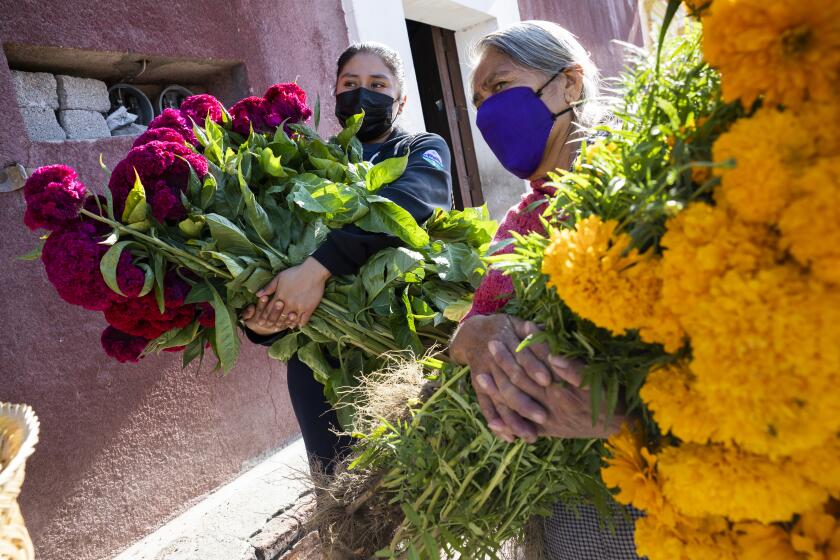For this Oaxacan merchant, marigolds mean more than ever this Día de Muertos
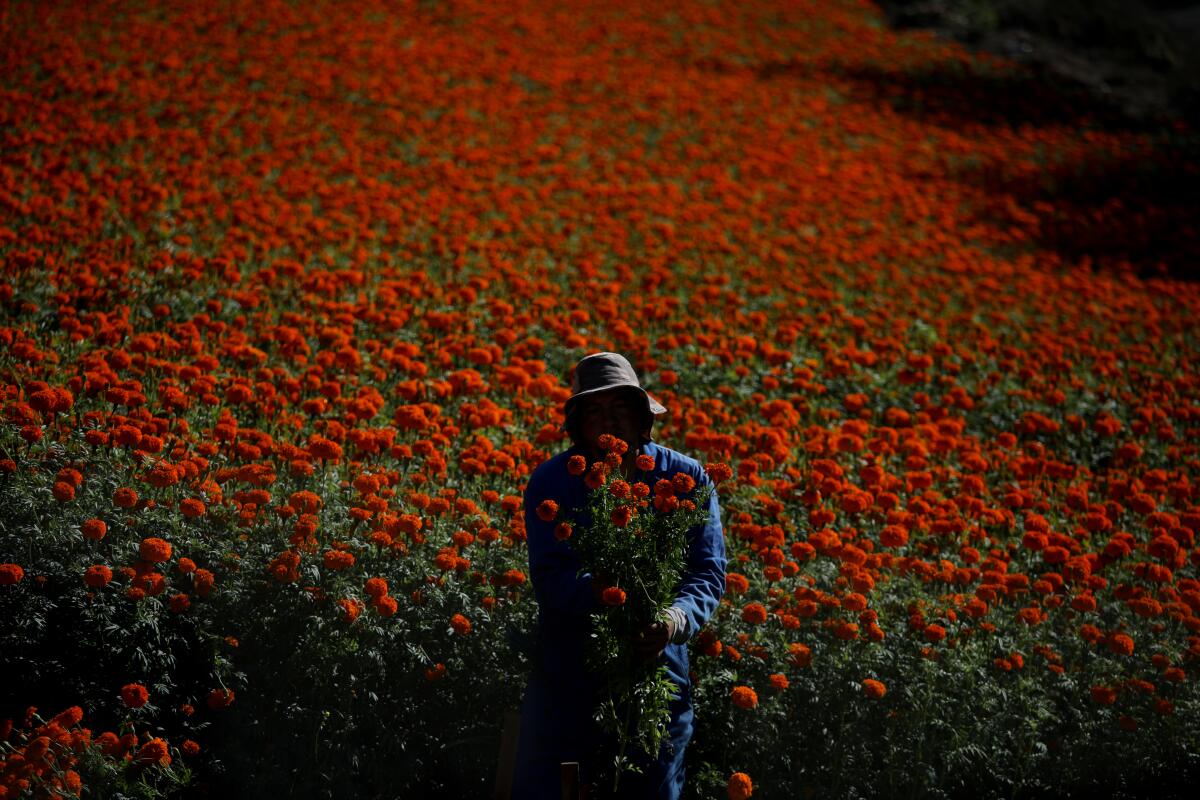
The 20,000 marigolds were blooming at just the right time.
They had to be picked and sold in five days, to beam their orange glory from Día de Muertos altars across Southern California.
Zeferino Garcia and a crew of eight men had been working under automobile high beams and halogen lights since 3 a.m. Friday, pulling each 5-foot-tall marigold plant from its base; cutting it with a curved, serrated knife; then placing the stalks on the ground in bunches. They angled themselves to avoid tumbling down the slope where the marigolds clustered tightly, resembling an immense, flattened Home Depot bucket.
At Garcia’s five-acre farm, Mi Rancho Conejo, cradled in the hills near Moorpark, they also were harvesting 20,000 cresta de gallo — cockscomb, in colors ranging from deep scarlet to wispy pink — for the holiday. The men were working for free in a mutual aid arrangement called gozona from their native region of Sierra de Juarez in Oaxaca, Mexico.
Once the sun rose, Garcia logged onto Facebook Live.
“A wonderful beauty, these marigold flowers,” he said in Spanish. He had taken off a puffy jacket to show off his camisa oaxaqueña — a long-sleeved shirt with intricate designs on the front pleats. “In a short time, you’ll be able to buy them at our stores.”
Garcia repeated the spiel in his native Zapotec.
Then someone shouted, “Coffee, boys!”
They gathered around a table to pour themselves cinnamon-laced café de olla, unwrap mole negro tamales and snack on anise-scented pan de muerto for dessert.
“Seeing these flowers, we remember our ancestors,” said Florentino Ambrosio, 65, a retired teacher who helped with the harvest but also took time to talk about marigold lore with Garcia in Spanish and Zapotec.
He explained that the flower’s Spanish name, cempasúchil, comes from a Nahuatl phrase meaning “20 petals,” referring to its brilliance.
Its smell, he said, is supposed to guide the departed back to the living, if only for a day.
Coverage of the Day of the Dead celebration in Mexico and California. The holiday is observed on Nov. 1-2.
For the record:
10:47 a.m. Nov. 2, 2022In an earlier version of this column, Zeferino Garcia’s village was referred to as San Fernando Yateé. It is San Francisco Yateé. Also, his wife, Maria Francisco, was incorrectly identified as Maria Fernando. Her brother, Jose Francisco, was also incorrectly identified as Jose Fernando.
Garcia first knew marigolds as yej kua — their name in the Zapotec dialect of his native San Francisco Yateé, a village high up in the Sierra de Juarez.
The nearest place to buy them was Oaxaca’s capital — a bumpy 13-hour bus ride through narrow mountain roads “that left you with welts on your head,” he recalled.
But villagers made the annual trek, bringing back baskets of them for All Saints’ Day and All Souls’ Day, the Catholic commemorations that fall on Nov. 1 and 2 and are now more commonly known as Día de Muertos.
Mexicans believe that on those days, the veil separating the worlds of the living and the dead is at its thinnest. There are many traditions and lore associated with what some call Día de los Muertos, but a virtual requisite is marigolds — the beacon for the departed to come back home.
Memories of the fresh flowers stayed with Garcia after he came to the United States in 1996.
He worked his way up from housecleaner to dishwasher to hot-dog vendor on the streets of Westwood to a successful entrepreneur serving Southern California’s massive Oaxacan community, with three produce markets that make their own breads and tortillas, a restaurant, a gift shop and a clothing boutique.
His wife, Maria Francisco, bought marigolds at the Original Los Angeles Flower Market to resell at their businesses whenever Day of the Dead came.
But “they weren’t like the ones back home,” she said. “They were too short here, with not enough color. Bloomed too early. So a vision came into my mind to grow them.”
“We had the tortillas, we had the mezcal, we had the tlayudas,” added Garcia. “We needed the cempasúchil.”
In 2018, they bought Mi Rancho Conejo, clearing the scrubby terrain with plans to plant tomatoes, mint, avocados and other crops to use at home and for their businesses.
A year later, Garcia brought marigold seeds from Oaxaca and tried to grow them, aiming to have them bloom just before Día de Muertos so he could sell them at their most luminous.
The seeds were sowed too early, which meant they bloomed weeks before his target. Still, customers bought Garcia out of everything.
Last year, winds knocked down many of the flowers when they were too young — but what was left sold out.
For the past three months, Garcia has zealously monitored the fields.
Jose Francisco taught himself how to drive a trailer to till the soil. Garcia and his friends planted the seedlings when they were 3 inches tall, after sprouting them at a nursery in Carpinteria.
People took turns watching over the drip irrigation system, clearing out weeds and making sure gophers didn’t gobble up anything.
This year, the marigolds bloomed right when they were supposed to.
The flowers — mostly orange, but some yellow — were as large as a fist. Each flower’s concentric petals unfolded like a math puzzle. Their pungent scent attracted bees that giddily bounced about each bunch.
“When one sees all this, you feel like you’re in Oaxaca,” Maria Francisco said. “You want to feel this. It’s great to see our culture thrive up here.”
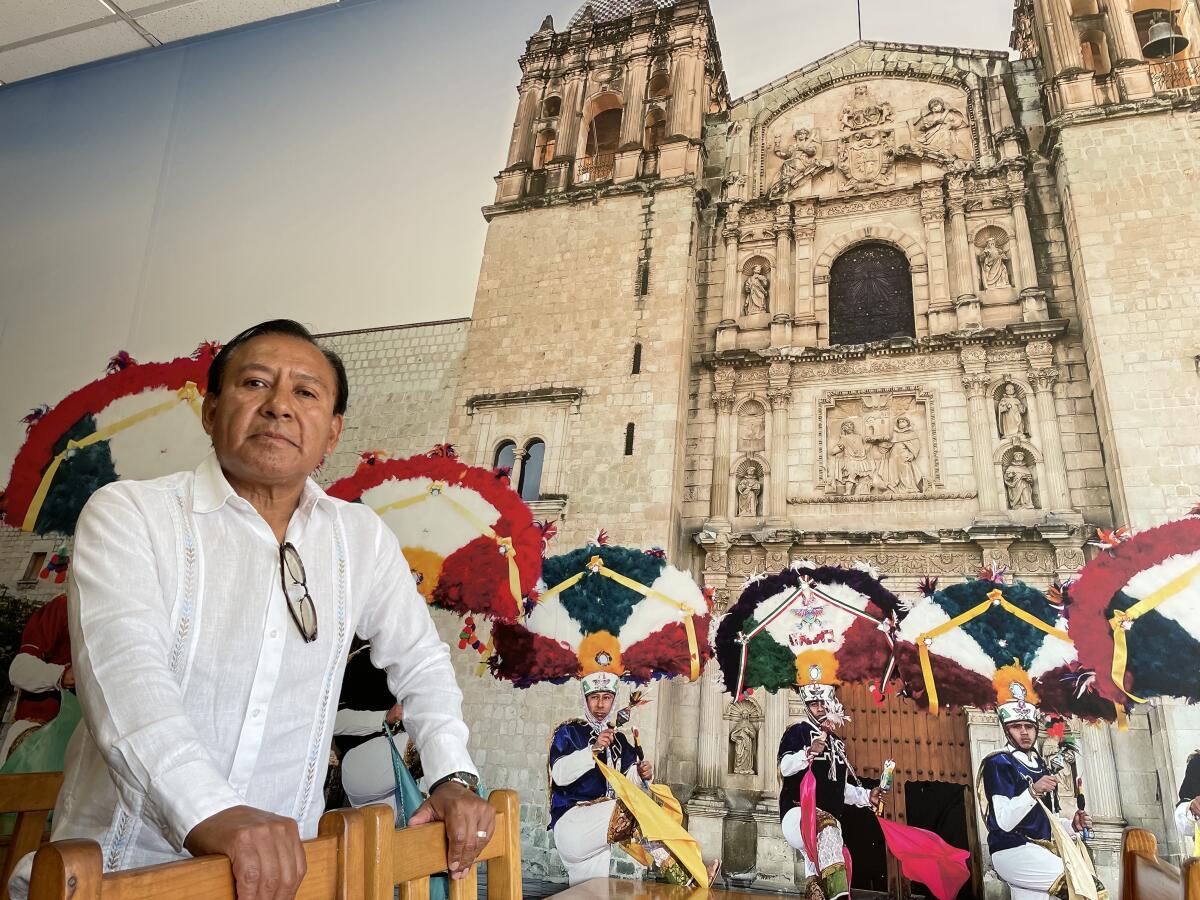
“You feel the heaviness of the work to pick everything, but when you see it all, you forget the heaviness,” said Jose Francisco, who’s a store manager at Garcia’s businesses but takes the lead at Mi Rancho Conejo during marigold season.
In a few hours, he would drive an air-conditioned box truck full of flowers to El Mayordomia #2, Garcia’s market that stands in the same shopping plaza as his restaurant, known alternately as Expresión Oaxaqueña and El Chapulín — the Grasshopper, Garcia’s nickname.
Some would be shipped as far away as Michigan and Oregon, but most would be sold at the family’s shops in L.A.
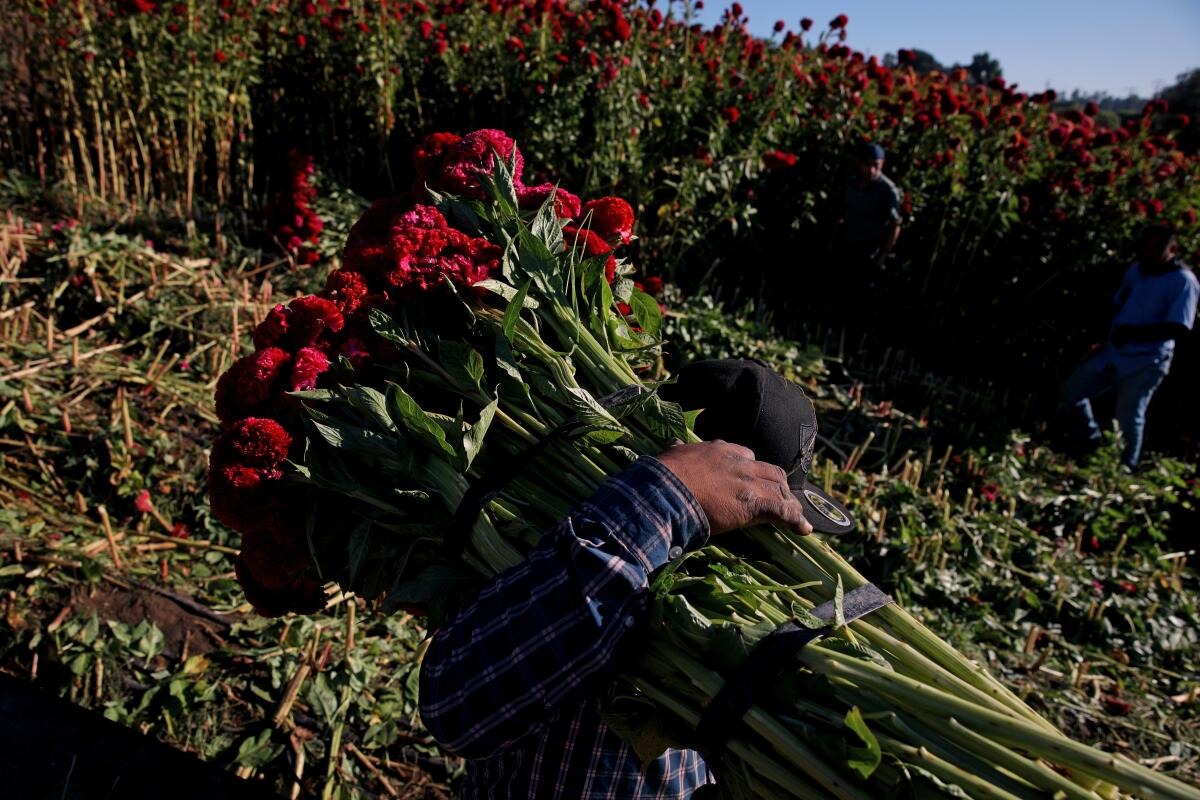
As Día de Muertos has grown in popularity among Latinos and non-Latinos alike, marigolds have become big business. U.S. Department of Agriculture figures show that wholesale revenue for the flowers last year topped $50.6 million, putting them just behind begonias and pansies.
They pop up for sale on street corners and supermarkets, as bouquets and in pots. Their use in altars and general decorations is becoming as much a part of the fall landscape in Southern California and beyond as jack-o’-lanterns.
On the drive along the 118 Freeway to catch the 5 Freeway toward El Chapulín, I saw far bigger marigold fields than Mi Rancho Conejo. But Garcia was the one farmer I wanted to talk to.
Oaxaca’s commemoration of Día de Muertos is widely acknowledged throughout Mexico as particularly vibrant and reverent.
And this year — this past month — marigolds meant more for Oaxacans in Los Angeles than perhaps ever before.
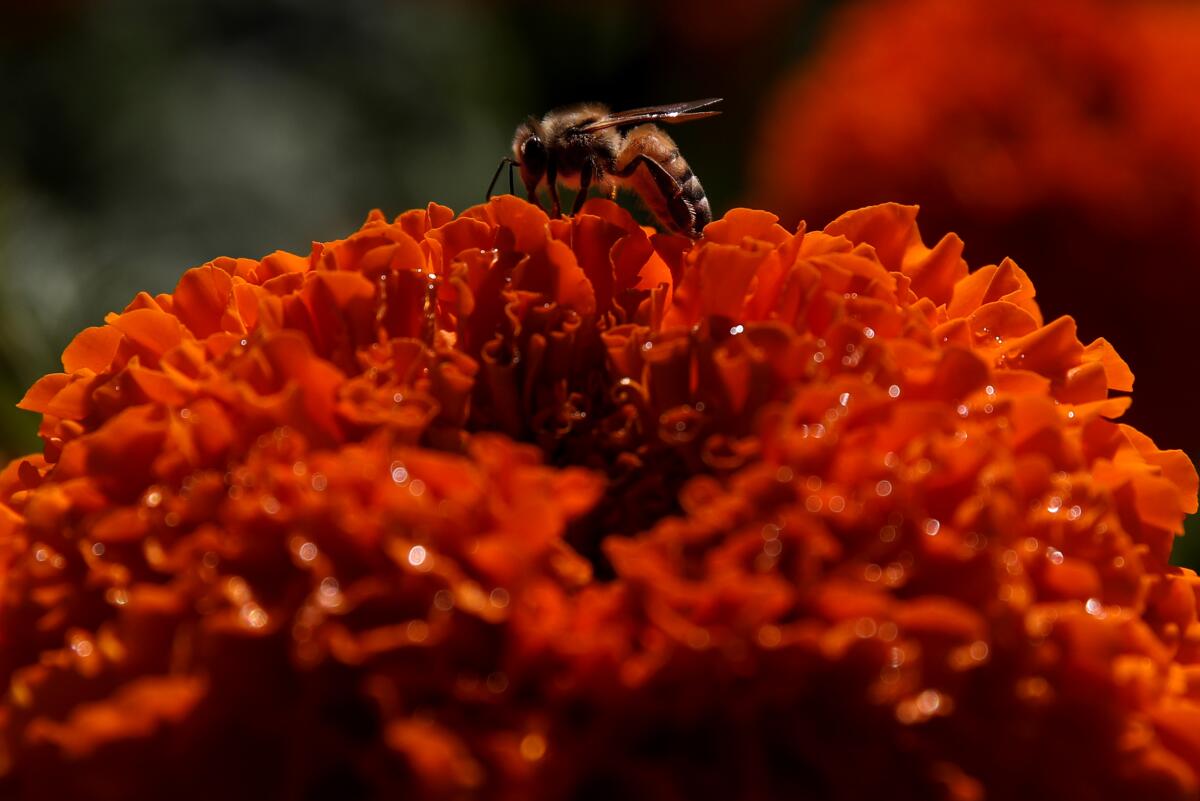
We were at El Chapulín, enjoying a quick lunch as Garcia waited for his brother-in-law to come in with a fresh shipment of marigolds. It was a down time for them.
By the weekend and through Wednesday, lines would form at Garcia’s businesses from sunrise to late night as people came to buy flowers and other items for their altars. The demand is so great that Garcia plans to double his marigold harvest next year.
Garcia had one more motive for celebrating Oaxacan culture. There was the matter of what he politely called “el bullying.”
Even in a feel-good story about flowers, the ugliness of a secretly recorded conversation that captured powerful Latino politicos trashing L.A.’s multicultural heart wasn’t far from our conversation.
On the leaked tape, then-L.A. City Council President Nury Martinez described Oaxacans as “little, short, dark people.” Outgoing councilmember Gil Cedillo laughed and called them “little ones.” Then-Los Angeles County Labor Federation President Ron Herrera dismissed them as “indios” — Indians. Councilmember Kevin de León marveled at how “some of them are wearing shoes.”
Martinez closed their ugly repartee with “¡’tan feos!” — they’re ugly.
As a Oaxacan in Los Angeles, Garcia was long used to other Mexicans discriminating against him, just like back in Mexico. But he was still disheartened to hear such enmity.
“The Creator has seen the strength we’ve brought here [to the United States],” Garcia said. His voice was soft, but he spoke with conviction. “Something positive, and with heart. We Oaxacans are very diverse. We’re short, we’re tall, we’re Black, we’re indigenous. That [tape] wakes up our enthusiasm to show who we are to the world.”
He pulled up a song from his iPhone: a waltz he composed in the brassy style of banda oaxaqueña as a gift for his daughter’s recent quinceañera.
“Remember that you came,” he crooned in a plaintive voice on the recording, “from a pueblo with values.”
“Who doesn’t work with Oaxacans in Los Angeles?” Garcia said, putting his phone away. “We’re strong people, but it seems even other Mexicans don’t know that. So we need to put ourselves out there even more, proud and strong.”
We walked over to La Mayordomia, named after the days-long festivals that are a vital part of Oaxacan cultural life and have carried over to Los Angeles. Workers had set up tables outside the market so Garcia, his wife and others could wrap marigold and cockscomb bouquets in plastic.
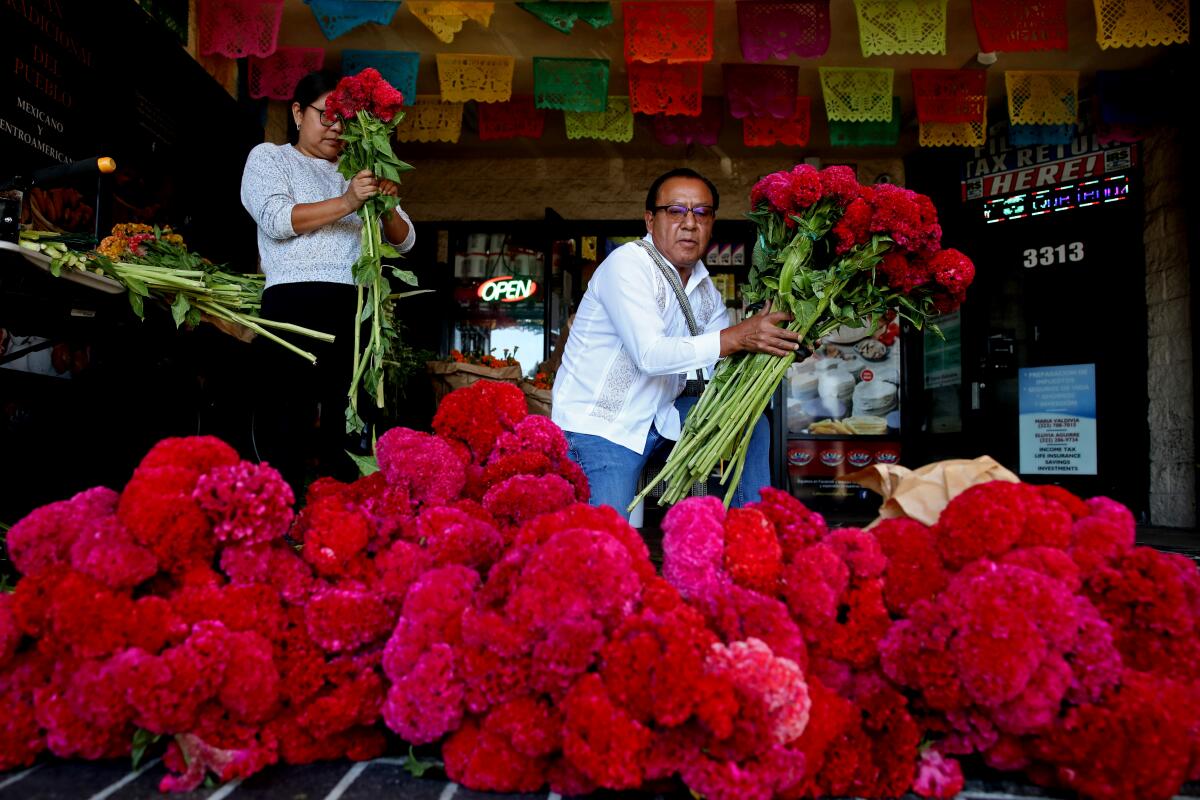
Customers grabbed flowers almost as soon as Garcia and Francisco laid them out. Margarita and Lalo Leyva, both natives of Oaxaca, left with two bouquets.
“It’s part of who we are,” said Margarita.
“These are just as beautiful as back home,” Lalo said. “Bigger, too!”
Garcia chatted with customers and directed his social media manager to take photos. Marigold season, he said, is a great time to take the temperature of his fellow Oaxacans.
“But the past couple of years have been tough,” he said. “I’ll ask a regular, ‘And Fidencio?’ And they’ll say, ‘Oh, he died of COVID.’ ‘What about el compa?’ ‘He died, too.’
“It’s sad,” he continued, “but that gives us more reason to do what we do.”
More to Read
Sign up for Essential California
The most important California stories and recommendations in your inbox every morning.
You may occasionally receive promotional content from the Los Angeles Times.
